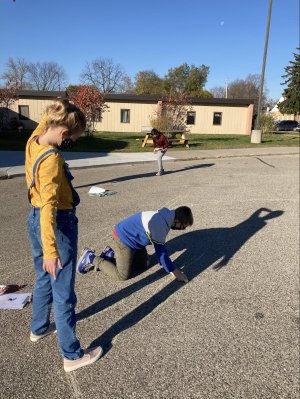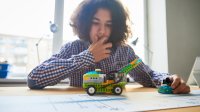4 Strategies to Make Virtual PBL Work
Researchers and educators share how to successfully transfer project-based learning to virtual second- through fifth-grade science classrooms.
Your content has been saved!
Go to My Saved Content.The national virtual educational response to COVID-19 has given us the opportunity to revisit what is really important for learning science and reconsider how to best engage students. We found ourselves asking again: What do we care most about? We care about social collaboration, immersing students in investigations of science phenomena, developing artifacts that demonstrate rigorous learning, and then presenting those artifacts for community use.
The Multiple Literacies in Project-Based Learning (ML-PBL) team is made up of researchers, curriculum developers, and teachers. We decided in March, when the first safer-at-home orders were issued, that we would not pivot away from the essential ingredients of science learning. We carefully reconfigured our face-to-face PBL units for grades K–5. These are some of the lessons learned from this collaborative endeavor, from four classrooms, second through fifth grade.
Lesson 1: Students can still build collaboratively.
Students need to work together, handling materials themselves, to be active participants—not observers. Working together during investigations and sharing thinking is an essential part of building a community of learners. Students learn from each other as the teacher facilitates the sensemaking.
Many teachers and researchers think that the projects should be built at home and then shared during virtual time. We disagree—the learning and social motivation are so important that we encourage building during online time.
In Stacey Hodkiewicz’s third-grade classroom, the project involved searching for materials around the home and then manipulating them to create a toy. While online, Shondra made a margarine lid into a flying toy, with fins to stabilize it. She described how unbalanced forces applied. Another student used a carton as a boat, with a makeshift cardboard sail. She blew on the boat to use a force to propel it forward, receiving feedback in the chat and verbally from her peers. Because the planning and design stage involved selecting and changing recycled materials, students were engaged physically, creatively, and intellectually.
Lesson 2: Use real-world examples to keep students engaged with science.
Project-based learning takes place in the real world and helps students see science all around them. One of the essential features of PBL is that students ask scientific questions based on experiencing phenomena firsthand in real time.

We encouraged students to participate together in shared science experiments and observations. In past years, students would focus on the same event, such as the entire class observing a squirrel outside. This mutual focus enabled students to build ideas together. Now, virtually, the same togetherness can be achieved through mutually occurring events and by streaming a teacher demonstration for all students.
Billie Freeland teaches science to multiple elementary grades. When students were learning about shadows, Billie asked her fourth-grade students to go outside for 10 minutes to observe their shadows in order to generate questions. Students brought their tablets. Some students used the iPad camera while on Zoom to show their shadows, allowing Billie to take a screenshot, and some students photographed their shadows and placed them on Google Slides.
Lesson 3: Gestures and nonverbal cues support communication.
We may not be aware of how important nonverbal communication is for students who are participating in sensemaking or collaborating around an artifact in PBL during face-to-face learning. Students rely on cues from the teacher and their peers—proximity, smiles, nods, eye contact, and gestures—to take risks, and they use the same prompts to gauge their own emerging understanding. For example, a student continues sharing a science idea when they notice the students next to them nodding and turning toward them.
During virtual lessons, we realized that students needed to practice and draw on their nonverbal communication. Stacey Hodkiewicz used a charades-style game for students to act out concepts in physics. She used a virtual name spinner to randomly select concepts, then asked the chosen student to show the science idea using gestures and objects. Then, after the other students tried the gesture, she had a volunteer explain how the action fit the science idea.
Lesson 4: Encourage students to show their learning in different ways.
In online PBL, students can draw models to show what they understand about how a phenomenon works. When students do all the creating themselves, instead of using previously created models, they make more elaborate models and understand the ideas better.
For simpler models, we found that students were able to show their thinking using virtual tools like Jamboard; but with models that required more sensemaking, drawn models with pencil and paper worked better. To focus on sensemaking, students can draw during the virtual time together, talking as they draw.
In Mary Modaff’s third-grade class, students used toy rockets and cars delivered to their homes to learn about physics. They created virtual models that showed the forces involved in starting and stopping motion using an animation tool (such as Seesaw or Doodly) and explained their models to each other. Then the teacher mixed up the medium, having students comment about revising the models in chats and on virtual stickies using Jamboard.
In Alice Severson’s fifth-grade class, students held up their completed models about energy transfer at the same time, and then the teacher pinned three of the models, one by one, to compare them. These models were complex, so the students used whiteboards and drew them by hand.
We found that keeping the projects firmly grounded in the real world is challenging in virtual environments but makes PBL science the most engaging part of our students’ screen-filled school day. While none of us know how long we’ll be online, we do know that we’re recognizing what we care most about for learning: keeping students motivated by doing science!
Multiple Literacies in Project-Based Learning (ML-PBL) was funded by Lucas Education Research of the George Lucas Educational Foundation.
